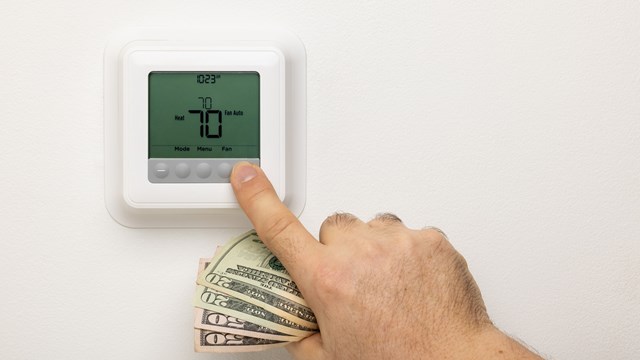
In 1863, when a tenant at 97 Orchard Street came home from work, he entered a pitch-dark hallway and had to feel his way up the stairs to his apartment. He most likely felt his way with one hand while carrying a bucket of coal for the stove, or a pail of water to wash with, in the other. There was no central lighting in the hallways, and his apartment was lit by candles or oil lamps. There was no running water. To use the toilet, he went out back to the six privies that the building shared with the patrons of the saloon that occupied the street level.
As utility technology advanced, the earliest middle-class family apartments were sometimes distinguished from low-rent tenements by their plumbing arrangements. By the mid-to-late1870s, most middle-class units had "water closets" or toilets, in the individual apartments, while tenements had either backyard privies or shared water closets in the common hallways. It was also more common to find fixed bathtubs in middle class-dwellings, while tenement families relied on washbasins or public bathhouses for personal hygiene.
Between 1890 and 1910, steam heat replaced fireplaces and wood-burning stoves in many - if not most - homes, and electric light made its first residential appearances, heralding the end of the gas-lit era. With the introduction of the mechanical elevator, buildings could go higher, and it became fashionable - rather than troublesome - to live on an upper floor, above the noise and smoke at street level.
Technology also eased many formerly backbreaking household tasks. In the Stuyvesant Apartments, built on East 18th Street in 1869, gas for lighting and running water were provided courtesy of pipes and hoses, leaving servants to use rope-and-pulley dumbwaiters to haul laundry from basement washtubs to the drying area on the roof, or to move trash down and supplies up. In luxury buildings like the Ansonia on Broadway, utilities were delivered via miles of pipes, ductwork, and conduits. The Ansonia's 340 units were equipped with thousands of electrical outlets, steam radiators, and gas and electrical outlets. Pneumatic tubes delivered messages and mail, and the more than 200 employees retained to run the building were more likely to be operating the elevators than hauling coal.
Since the early 19th century, gas manufactured from coal lit both street lamps and many domestic lamps, replacing the oil that had been used since the earliest English and Dutch settlements. In 1823, the New York Gas Light Company obtained a 30-year exclusive franchise from the city to lay underground gas pipes in the area south of Grand Street. Several other gas companies gained franchises between 1858 and 1878, but the gas industry met with competition from a new source in 1880. In December of that year, the Brush Electric Light Company illuminated its electric arc street lamps along Broadway between 14th and 34th Streets for the first time, earning the stretch of street its enduring nickname; The Great White Way. At about the same time, a group of New York City aldermen were visiting Thomas Alva Edison's lab in Menlo Park, New Jersey to see Edison's generators and the new incandescent lamps he was using to light the streets of that city.
Edison promised the New York officials a savings of 33 percent based on the light output for the electric lamps versus the gas lamps currently in use. Edison proposed a plan to illuminate 51 blocks of Lower Manhattan with sufficient power for 8,400 lamps. The aldermen were extremely impressed and awarded the Edison Illuminating Company of New York the first electrical franchise in April 1881.
Following the award, Edison purchased 255 and 257 Pearl Street to house the giant "dynamo" or generator that he would use to power the square-mile system south of Fulton Street. Edison knew from the start he would have to lay underground cables for his system. Lower Manhattan was already a forest of utility poles, and scantily insulated wires that often emitted sparks that were responsible for the deaths of many a municipal worker. The franchise from the city allowed the Edison Company to dig up the streets provided it did not damage any of the sewage, water or gas pipes that were already in place.
On September 4, 1882, the chief electrician at the Pearl Street station threw the master switch for the first time and Edison personally connected the lamps in the offices of one of his major backers, J.P. Morgan. A reporter for the New York Herald wrote "In a twinkling, the area bounded by Spruce, Wall, Nassau and Pearl Streets was in a glow."
That first generator produced enough power to light just 800 bulbs - but within 14 months, Edison's company was putting out enough power for 508 subscribers and some 12,732 lightbulbs.
Electricity wasn't limited to lighting up the night, however. In the 1890s, an electric trolley system was implemented that served New York City until the early 1930s, after which the General Motors Company purchased the city's municipal electric railway system and began converting to diesel-fueled buses.
Demand for electric lighting in private homes, however, increased rapidly, if somewhat unevenly in some neighborhoods. According to Long, electricity was not brought into 97 Orchard Street until the 1920s.
"Gas lighting technology had improved so much that you could get the same illumination as electricity," says Long, adding that the technology to install electric lines was still very expensive. A "pay as you go" meter in each apartment supplied gas. Long says one former resident of the building recalled that a quarter would buy about a week's worth of gas.
By the early 1900s, however, many other new electrical inventions were introduced. A pamphlet for the 1905 Electrical Show, held at Madison Square Garden, invites visitors to view exhibits of "model kitchens where practical demonstrations of the use of electrical machinery are being conducted continuously through the mediums of stoves, ovens, chafing dishes, coffee urns, tea pots and also curling iron heaters, warming bags, laundry irons and numberless other devices for the home."
Other modern conveniences exhibited at the show included a "household refrigerating cabinet" that not only served as a refrigerator but also "manufactures ice for the table." The advantages of cooking with electric utensils were touted by the Prometheus Electric Company, which says electric devices have "The absence of smoke, flame and soot"¦No danger from fires or explosions. Small cost of working, if properly used."
The electrical appliances did catch on. By 1910, nearly half of the electricity sold in New York City was used to operate electrical motors, appliances, and other non-lighting applications.
In the late 1890s, electricity was available in all of the developed areas of Manhattan. By the early 20th century, the new technology was affecting the way apartment dwellers lived. Apartment buildings were designed from the start with centralized heating, hot and cold running water, and steam laundries in the basement connected to apartments by dumbwaiters.
By the end of the 1920s, smaller electric motors had been developed and had become more affordable. As more and more households started using the new appliances, architects and designers were carefully planning room layouts and outlet placements to accommodate the new conveniences.
Not only were floor plans changed, but buildings themselves began to grow as electricity enabled elevators to go higher and modern plumbing improved water pressure in tall buildings. As the skyline climbed upward, New Yorkers with the means to get off the ground, did.
Transportation improvements sparked by the new electric age also radically changed the way New Yorkers lived. Horse-drawn wagons and carriages soon paved the way for the era of the automobile and the streetcar. Electric trolley service was instituted in the early 1890s thus providing an easier means of travel to the outer boroughs. According to the New York City Transit Museum, the development of the New York City subway system began in the form of elevated railway lines or "the el" in the late 1880s. "By allowing people - many thousands at a time - to travel quickly and cheaply to the city's first skyscrapers, department stores and entertainment districts, the elevated railway led the way as New York transformed itself into a modern, world metropolis," says the museum's Web site. Easier transportation led to a boom in population - and energy consumption, putting yet more demands on New York City's power supply.
Since the evolution of Edison's invention, New Yorkers have become accustomed to just flicking on a switch and having the lights go on or turning on the air conditioner full blast to offer a little relief from the sweltering summer heat. But what happens if the lights don't go on and subway cars and elevators stop dead in their tracks?
That's exactly what happened when two major blackouts in 1965 and 1977 paralyzed New York City and exposed the vulnerability of the power grid that runs the city that never sleeps.
As rush hour approached 5:15 p.m. on November 9, 1965, the entire Northeast and parts of Canada were thrown into total darkness when a transmission line servicing the upstate Niagara, N.Y.-Ontario, Canada grid failed causing a domino effect and draining the entire electrical system. Unable to meet demand caused by the blown relay, the generator operators, one by one, triggered the shutdown of their equipment. Soon the entire region from New Hampshire, Vermont, Massachusetts, Connecticut, Rhode Island, New York to metropolitan New York City and some portions of Pennsylvania flickered and went black. According to The New York Times account of the Great Northeast Blackout in "The Night the Lights Went Out," by A.M. Rosenthal, the energy-dependent metropolis was brought to a standstill.
"All subways and elevators and electrically-powered trains stopped. All lights were out. Factories ground to a halt. Traffic moved with difficulty because there were neither stoplights nor street lamps. Facilities from prisons to zoos, colleges to greenhouses, were black and cold and still while their inhabitants groped in the darkness. Mothers in stalled trains and darkened homes tried to comfort their squalling children. The suppers on millions of stoves grew cold. No gasoline could be pumped at service stations. Commuters were stopped in their tracks. Millions of television and radio sets crackled and died. To some, it seemed as though the world were ending at last," wrote The Times.
"New York City, the most dependent on electricity for its manifold and wondrous activities, was the hardest hit. Thousands were trapped in elevators like hamsters in their cages; 800,000 were in the inert subways, tens of thousands were in the train and bus stations and in the air overhead. The metropolis was a black, suffering pool of inactivity, bathed only in the glare of automobile headlights and the lambent light of the indifferent moon."
In 1977, the electrical power failure hit at 9:36 p.m. on the evening of July 13th. The cause, according to Con Ed, was attributed to failed transmission lines damaged by a series of severe thunderstorms and subsequent lightning strikes. This blackout lasted 25 hours, 13 hours longer than the '65 event, and affected 9 million people living in New York City and Westchester County.
The reaction of the populace to the '77 blackout was not one of fear and was certainly not what public officials had expected. Large-scale civil disorder and unrest broke out almost immediately. Chaos reigned in neighborhoods from Manhattan to Bedford-Stuyvesant to the South Bronx as thousands of stores and shops were looted and fires raged in the streets. During the 1965 blackout, 96 arrests were made and crime rates actually fell. In '77, the New York City police department arrested 3,776 people, mostly for vandalism and looting offenses, and the FDNY were called upon to fight more than 1,000 fires that erupted through the night in Queens, Brooklyn, Manhattan and the Bronx.
"For a night and a day, nothing worked except telephones, transistor radios and a certain gritty New York resilience in the face of disaster," recounted Newsweek. "Subways ran dead. Elevators hung high in their shafts. Water pumps failed, and with them sinks, tubs and toilets. Streetlights and stoplights went out. Traffic thinned and slowed to a wary crawl. Refrigerators and air coolers quit. Commuter lines stalled. Stores, banks, businesses and stock exchanges closed. Theaters went dark. Office towers stood nearly empty. Airports shut down. Hospitals switched to backup generators when they worked and flashlight medicine when they did not. Produce wilted and frozen food melted in stores. The stranded flaked out in hotel-lobby floors."
Time reported that many New Yorkers gamely went on with their lives during the crisis. "Broadway actors performed under the uncertain beams of flashlights held by stagehands; the nude cast of Oh! Calcutta unable to grope to their dressing rooms, borrowed clothes from members of the audience and went home in cabs. Waiters at Manhattan restaurants served patrons by candlelight. Buses were delayed only slightly by darkened traffic lights. Garbage trucks whined as usual on their nightly rounds," said the magazine.
The ultimate result of dealing with the twin blackouts created renewed awareness on the part of Con Ed and other city agencies so that such a major outage would not reoccur.
Today, 120 years after the master switch at Pearl Street was thrown for the first time, electricity is no longer an amenity but a necessity. The abundance of electrical appliances eventually began to tax the system and force companies to look for new energy sources and improvements to the distribution system. The infrastructure started by Edison when electric power was in its infancy has expanded to a service area of 660 square miles, encompassing 90,000 miles of cable, and providing power to 8.3 million customers.
According to Joseph Petta, a spokesperson for Con Edison - the utility that provides electric service to the majority of New York City and most of Westchester County - the company is constantly maintaining and upgrading the distribution system.
"One of the most important aspects of what we do is improvements," says Petta, adding that this year the company will spend approximately $500 million on upgrades.
Just as in Edison's day, providing reliable power is critical, says Petta. Blackouts during bad weather or heat waves can prove not just inconvenient, but deadly. Impressive as the city's power grid is, a few 90-plus-degree days in a row, and the system is taxed to the maximum.
As the city's population grows, Petta says there is localized demand in certain areas, one of which is the Chelsea section of Manhattan, where Con Ed is interested in building a new subsystem to meet increased demand.
Today the advent of nuclear power supplements the metro area's existing energy needs but it seems that any new technological advancements only increase our dependence on energy. Nuclear energy provides about 20 percent of total U.S. electricity, according to Entergy Corporation, a global energy company, that operates the Buchanan, N.Y.-based Indian Point Nuclear Power Plant, a facility that environmentalists are demanding be shut down. After September 11th, many activists are calling for the closure of nuclear plants due to security and safety concerns.
Overall, a large increase in capacity is projected over the next three years. According to a March 2002 report by the New York Independent System Operator, "Even with the downturn in the economy and the effects of September 11, New York State still needs an additional capacity of 7,100 megawatts by 2005 - of which 2,000 to 3,000 [megawatts] must be located in New York City." One megawatt is enough energy to power 1,000 average homes.
New York City has come a long way since the residents of 97 Orchard Street hauled coal and oil up to their dark, drafty homes. Today, the city grid glows like an electric tapestry, marking in lights the path we've taken from candles to giant generators. One can only imagine what the New Yorkers of 200 years ago would think of the non-stop riot of neon, LED screens, and electric bulbs that is modern-day Times Square, or what Thomas Edison would say about the latest incarnations of his "dynamo" that produce enough juice to power millions and millions of homes. One thing's for sure, however: it's been a while since the city that never sleeps was truly in the dark.
M






Leave a Comment